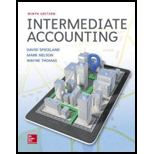
Concept explainers
Various inventory transactions;
• LO8–1 through LO8–3
James Company began the month of October with inventory of $15,000. The following inventory transactions occurred during the month:
a. The company purchased merchandise on account for $22,000 on October 12, 2018. Terms of the purchase were 2/10, n/30. James uses the net method to record purchases. The merchandise was shipped f.o.b. shipping point and freight charges of $500 were paid in cash.
b. On October 31, James paid for the merchandise purchased on October 12.
c. During October merchandise costing $18,000 was sold on account for $28,000.
d. It was determined that inventory on hand at the end of October cost $19,060.
Required:
1. Assuming that the James Company uses a periodic inventory system, prepare journal entries for the above transactions including the
2. Assuming that the James Company uses a perpetual inventory system, prepare journal entries for the above transactions.
1.
Periodic Inventory System: It is a system in which the inventory is updated in the accounting records on a periodic basis such as at the end of each month, quarter or year. In other words, it is an accounting method which is used to determine the amount of inventory at the end of each accounting period.
Perpetual Inventory System refers to the inventory system that maintains the detailed records of every inventory transactions related to purchases and sales on a continuous basis. It shows the exact on-hand-inventory at any point of time.
To Record: The journal entries using periodic inventory system.
Explanation of Solution
a. Record the entry for purchase on account.
| Date | Account Title and Explanation | Post Ref. |
Debit ($) |
Credit ($) |
| October 12, 2018 | Purchases | 21,560 (1) | ||
| Accounts Payable | 21,560 | |||
| (To record the purchase of inventories on account) |
Table (1)
Working Note:
Compute the purchase price of the inventory.
- Purchases account is an expense and it is decreased the equity value by $21,560. Therefore, debit purchase account with $21,560.
- Accounts payable is a liability and it is increased by $21,560. Therefore, credit accounts payable account with $21,560.
Record the freight paid.
| Date | Account Title and Explanation | Post Ref. |
Debit ($) |
Credit ($) |
| October 12, 2018 | Freight-in | 500 | ||
| Cash | 500 | |||
| (To record the freight cost) |
Table (2)
- Freight-in account is an expense and it is decreased the equity value by $500. Therefore, debit freight-in account with $500.
- Cash is an asset and it is decreased by $500. Therefore, credit cash account with $500.
b. Record the payment of accounts payable.
| Date | Account Title and Explanation | Post Ref. |
Debit ($) |
Credit ($) |
| October 31, 2018 | Accounts Payable | 21,560 (1) | ||
| Interest Expense | 440 (2) | |||
| Cash | 22,000 | |||
| (To record the payment made to the supplier) |
Table (3)
Working Note:
Compute the interest expense.
- Accounts payable is a liability and it is decreased by $21,560. Therefore, debit accounts payable account with $21,560.
- Interest expense account is an expense and it is decreased the equity value by $440. Therefore, debit interest expense account with $440.
- Cash is an asset and it is decreased by $22,000. Therefore, credit cash account with $22,000.
c. Record the sales entry.
| Date | Account Title and Explanation | Post Ref. |
Debit ($) |
Credit ($) |
| October 2018 | Accounts Receivable | 28,000 | ||
| Sales Revenue | 28,000 | |||
| (To record the sales on account) |
Table (4)
- Accounts receivable is an asset and it is increased by $28,000. Therefore, debit accounts receivable account with $28,000.
- Sales revenue is revenue and it increases the value of equity by $28,000. Therefore, credit sales revenue with $28,000.
Note:
There is no entry required for cost of goods sold under the periodic method.
d. Record the year-end adjusting entry.
| Date | Account Title and Explanation | Post Ref. |
Debit ($) |
Credit ($) |
| October 31, 2018 | Cost of Goods Sold (Refer Table 6) |
18,000 | ||
| Ending Inventory | 19,060 | |||
| Beginning Inventory | 15,000 | |||
| Purchases | 21,560 | |||
| Freight-in | 500 | |||
| (To record the cost of goods sold) |
Table (5)
Working Note:
Calculate the cost of goods sold.
| Particulars | Amount ($) | Amount ($) |
| Beginning Inventory | 15,000 | |
| Add: Net Purchases | ||
| Purchases | 21,560 | |
| Freight-in | 500 | 22,060 |
| Cost of goods available for sale | 37,060 | |
| Less: Ending Inventory | (19,060) | |
| Cost Of Goods Sold | 18,000 |
Table (6)
- Cost of Goods Sold and Ending Inventory generally shows a credit balance. Therefore, to close these accounts, it should be debited. Therefore, debit all the above mentioned accounts with their respective amounts.
- Beginning Inventory, Purchases, and Freight-In generally shows a debit balance. Therefore, to close these accounts, it should be credited. Therefore, credit all the above mentioned accounts with their respective amounts.
2.
To Record: The journal entries using perpetual inventory system.
Explanation of Solution
a. Record the entry for purchase on account.
| Date | Account Title and Explanation | Post Ref. |
Debit ($) |
Credit ($) |
| October 12, 2018 | Inventory | 21,560 | ||
| Accounts Payable | 21,560 | |||
| (To record the purchase of inventories on account) |
Table (7)
- Inventory is an asset and it is increased by $21,560. Therefore, debit inventory account with $21,560.
- Accounts payable is a liability and it is increased by $21,560. Therefore, credit accounts payable account with $21,560.
Record the freight paid.
| Date | Account Title and Explanation | Post Ref. |
Debit ($) |
Credit ($) |
| Inventory | 500 | |||
| Cash | 500 | |||
| (To record the freight cost) |
Table (8)
- Inventory is an asset and it is increased by $500. Therefore, debit inventory account with $500.
- Cash is an asset and it is decreased by $500. Therefore, credit cash account with $500.
b. Record the payment of accounts payable.
| Date | Account Title and Explanation | Post Ref. |
Debit ($) |
Credit ($) |
| October 31, 2018 | Accounts Payable | 21,560 (1) | ||
| Interest Expense | 440(2) | |||
| Cash | 22,000 | |||
| (To record the payment made to the supplier) |
Table (9)
- Accounts payable is a liability and it is decreased by $21,560. Therefore, debit accounts payable account with $21,560.
- Interest expense account is an expense and it is decreased the equity value by $440. Therefore, debit interest expense account with $440.
- Cash is an asset and it is decreased by $22,000. Therefore, credit cash account with $22,000.
c. Record the sales entry.
| Date | Account Title and Explanation | Post Ref. |
Debit ($) |
Credit ($) |
| October 2018 | Accounts Receivable | 28,000 | ||
| Sales Revenue | 28,000 | |||
| (To record the sales on account) |
Table (10)
- Accounts receivable is an asset and it is increased by $28,000. Therefore, debit accounts receivable account with $28,000.
- Sales revenue is revenue and it increases the value of equity by $28,000. Therefore, credit sales revenue with $28,000.
The following is the journal entry.
| Date | Account Title and Explanation | Post Ref. |
Debit ($) |
Credit ($) |
| October 2018 | Cost of Goods Sold | 18,000 | ||
| Merchandised Inventory | 18,000 | |||
| (To record the cost of goods sold) |
Table (11)
- Cost of goods sold is an expense account and it decreases the value of equity by $18,000. Therefore, debit cost of goods sold account with $18,000.
- Inventory is an asset and it is decreased by $18,000. Therefore, credit inventory account with $18,000.
d. Record the year-end adjusting entry.
Note:
No entry required for the year-end adjusting entry under perpetual inventory system.
Want to see more full solutions like this?
Chapter 8 Solutions
Intermediate Accounting
- Lower-of-cost-or-market inventory Data on the physical inventory of Katus Products Co. as of December 31 follows: Description Inventory Quantity Market Value per Unit (Net Realizable Value) A54 37 56 C77 24 178 F66 30 132 H83 21 545 K12 375 5 Q58 90 18 S36 8 235 V97 140 20 Y88 17 744 Quantity and cost data from the last purchases invoice of the year and the next-to-the-last purchases invoice are summarized as follows: Description Last Purchases Invoice Next-to-the-Last Purchases Invoice Quantity Purchased Unit Cost Quantity Purchased Unit Cost A54 30 60 40 58 C77 25 174 15 180 F66 20 130 15 128 H83 6 547 15 540 K12 500 6 500 7 Q58 75 25 80 26 S36 5 256 4 260 V97 100 17 115 16 Y88 10 750 8 740 Instructions Determine the inventory at cost and also at the lower of cost or market, using the first-in, first-out method. Record the appropriate unit costs on the inventory sheet, and complete the pricing of the inventory. When there are two different unit costs applicable to an item, proceed as follows: 1. Draw a line through the quantity, and insert the quantity and unit cost of the last purchase. 2. On the following line, insert the quantity and unit cost of the next-to-the-last purchase. 3. Total the cost and market columns and insert the lower of the two totals in the LCM column. The first item on the inventory sheet has been completed as an example. Inventory Sheet December 31 Description Unit Inventory Quantity Cost per Unit Market Value per Unit(Net Realizable Value) Total Cost Market LCM A54 37 30 60 56 1,800 1,680 7 58 56 406 392 2,206 2,072 2,072arrow_forward(Appendix 8.1) Inventory Write-Down Frost Companys inventory records tor the years 2019 and 2020 reveal the cost and market of the January 1, 2019, inventory to be 125,000. On December 31, 2019, the cost of inventory was 130,000, while the market value was only 128,000. The December 31, 2020, market value of inventory was 140,000, and the cost was only 135,000. Frost uses a periodic inventory system. Purchases for 2019 were 100,000 and for 2020 were 110,000. Required: 1. Assume the inventory that existed at the end of 2019 was sold in 2020. Prepare the journal entries at the end of 2019 and 2020 to record the lower of cost or net realizable value under the (a) allowance method and (b) direct method. 2. Prepare the cost of goods sold section of the income statement and show how the company would record the inventory on its balance sheet for 2019 and 2020 under the (a) allowance method and (b) direct method. 3. Next Level Refer to your answer for P8-3. How does the use of a periodic inventory system versus a perpetual inventory system affect the valuation of inventory and the amount reported as income?arrow_forward
 Corporate Financial AccountingAccountingISBN:9781337398169Author:Carl Warren, Jeff JonesPublisher:Cengage Learning
Corporate Financial AccountingAccountingISBN:9781337398169Author:Carl Warren, Jeff JonesPublisher:Cengage Learning Corporate Financial AccountingAccountingISBN:9781305653535Author:Carl Warren, James M. Reeve, Jonathan DuchacPublisher:Cengage Learning
Corporate Financial AccountingAccountingISBN:9781305653535Author:Carl Warren, James M. Reeve, Jonathan DuchacPublisher:Cengage Learning Financial & Managerial AccountingAccountingISBN:9781337119207Author:Carl Warren, James M. Reeve, Jonathan DuchacPublisher:Cengage Learning
Financial & Managerial AccountingAccountingISBN:9781337119207Author:Carl Warren, James M. Reeve, Jonathan DuchacPublisher:Cengage Learning Intermediate Accounting: Reporting And AnalysisAccountingISBN:9781337788281Author:James M. Wahlen, Jefferson P. Jones, Donald PagachPublisher:Cengage Learning
Intermediate Accounting: Reporting And AnalysisAccountingISBN:9781337788281Author:James M. Wahlen, Jefferson P. Jones, Donald PagachPublisher:Cengage Learning



